|
Lee Decides to invade the North
After the Confederate humiliation of Hooker's Union troops at
Chancellorsville (early May), Lee seemed to take the attitude that the
Confederacy's best weapon was its audacity. The fighting spirit
of the Southern armies had certainly thus far acquitted the Confederacy
very admirably in its major military engagements with the North.
Lee also knew that war weariness was growing in the North. Voices
calling on Lincoln simply to let the South slip away were increasing in
number and in importance within the North. Lee hoped that one
more daring – and devastating – confrontation with the Northern Armies
might play so strongly into the hands of the peace party that the North
might be ready for terms acknowledging the independence of the Southern
states.
Thus he decided to strike deep into Northern territory with his Army of
Northern Virginia. On June 6th Lee began moving his forces out of
the Chancellorsville- Fredericksville area, leaving one of his three
corps (Hill's corps) behind to prevent Hooker's troops from crossing
the Rappahonnock and following the Confederates north. He wanted
as much as possible to keep his movements – and his intentions – hidden
from the North.
With his other two corps (Ewell's and Longstreet's) he began his move
to the northwest in order to cross the Blue Ridge mountains and move
northward through the Shenandoah Valley.
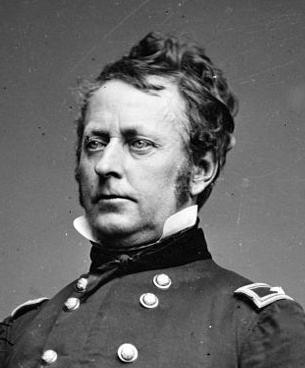 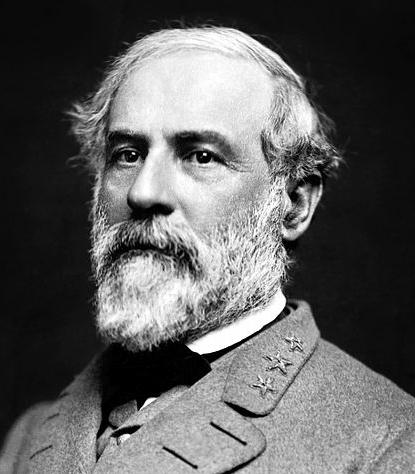
Generals Joe Hooker and Robert E. Lee
Brandy Station (June 9)
But a surprise awaited the Confederates when on June 9th, Hooker's
cavalry corps (under the command of Gen. Pleasanton) encountered the
Confederate cavalry corps (under the command of the almost legendary
Jeb Stuart). Stuart's horsemen had been gathering at Brandy
Station, readying themselves to accompany Lee's main forces in their
move to the North.
Hearing news of the gathering, Pleasanton had taken the initiative to
attack Stuart – and came very close to defeating Stuart with his
unexpected assault. The battle ended finally when Pleasanton
called his troops to a retreat.
Though Stuart had certainly not lost the battle – neither had he won
it, and his enormous pride suffered terribly from the humiliation of
not being able to live up to his reputation for victory. The
consequences of this otherwise minor action would ultimately be very
significant: Stuart, sensitive to the need to restore his
tarnished reputation, would become more focused on securing daring
exploits for himself and his men – than on following the explicit orders
of Lee to provide close protection to Ewell's right flank as the
Confederate army moved northward – and to stay in close touch with Lee
so that he would know constantly the exact whereabouts and movements of
the Union army. Indeed, at the crucial moment when later Lee
would encounter the first elements of the enemy in the North
(Gettysburg), the whereabouts of Stuart (who was off conducting raids
in the Pennsylvania countryside) would be a total mystery – leaving Lee
to have to guess blindly about the placement and size of the Union army
that was gathering to fight him.
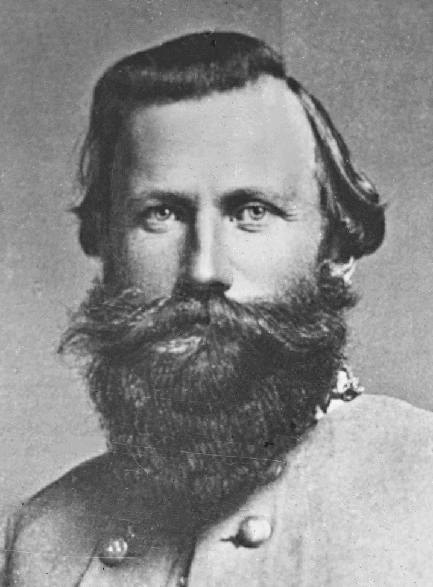 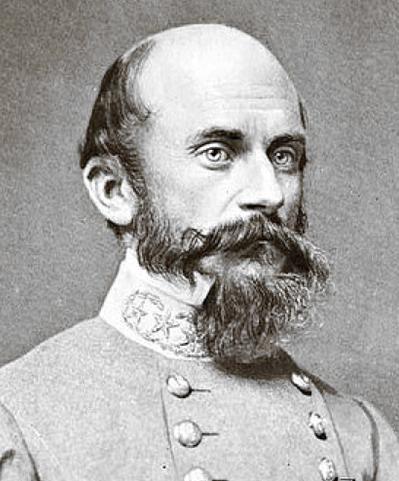
Confederate Generals J.E.B.("Jeb") Stuart and Richard S. Ewell
The Confederates move north rapidly (mid / late June)
On June 14th Union troops were caught by surprise and overwhelmed at
Winchester and further north at Martinsburg by Ewell's Corps. The
following day Ewell reached the Potomac, Longstreet's Corps and
Stuart's Cavalry were moving northward along the east side of the Blue
Ridge, and Hill was beginning his pullout from Fredericksburg in order
to join the rest of the Confederate army moving north.
The Union General Hooker however was not sure of what to make of the
reports of these Confederate movements. When he first realized
that only Hill's troops remained across from him in Fredericksburg he
wanted to attack Hill – and then move south to seize Richmond while Lee
was away in the North. But Lincoln commanded Hooker to go after
Lee's army instead, insisting that seizing Richmond without having
defeated Lee would be a meaningless victory – and would leave the North
unprotected. So Hooker began to move North to follow Lee, and to
protect Washington, if that was Lee's objective.
Along the way there were a number of Union cavalry skirmishes with
Stuart to the east of the Blue Ridge, at and around Middleburg (Aldie,
Middleburg and Upperville). But these did little to either slow
up Lee – or give Hooker any indication of what the Confederates were up
to.
It became more obvious that Lee was attempting a daring strike into the
previously unchallenged North as Ewell's troops crossed rapidly through
Maryland and entered Pennsylvania, where they attacked Chambersburg and
then began to spread throughout the countryside in a hunt for
supplies. Part of Ewell's Corps, under the division commander
Jubal Early, moved eastward from Chambersburg, to Gettysburg, and then
beyond to York – even reaching the Susquehanna south of Harrisburg on
the 29th of June. At the same time, two other of Ewell's
divisions, under Robert Rodes and Edward Johnson, moved north from
Chambersburg, entering Carlisle unchallenged. Harrisburg now
found itself threatened from the South and the West by Ewell's Corps.
Also Longstreet's and Hill's two corps had reached Chambersburg by the 27th and then turned eastward toward the Cashtown pass.
Consternation in the Union ranks: Meade replaces Hooker
The news that Lee had crossed the Potomac and had even entered
Pennsylvania finally (June 25th) led Hooker to move his army northward
from Virginia into Maryland, in the direction of Frederick.
Meanwhile the Pennsylvanians were gearing up to provide defense for
their capital by rallying the Pennsylvania militia.
It was at this moment (June 27th) that Hooker, in a fit of pique,
offered to resign his command – only to have Lincoln immediately accept
the proposal. Lincoln turned quickly to replace him with General
George Meade, a rather unassuming, though capable general. On the
following day, June 28th, Meade was stunned to learn of these
developments. But given the urgency of the moment, he had no time
to quibble or protest. As the new commander of the Union's Army
of the Potomac, he had to move quickly to prevent a catastrophe from
happening.
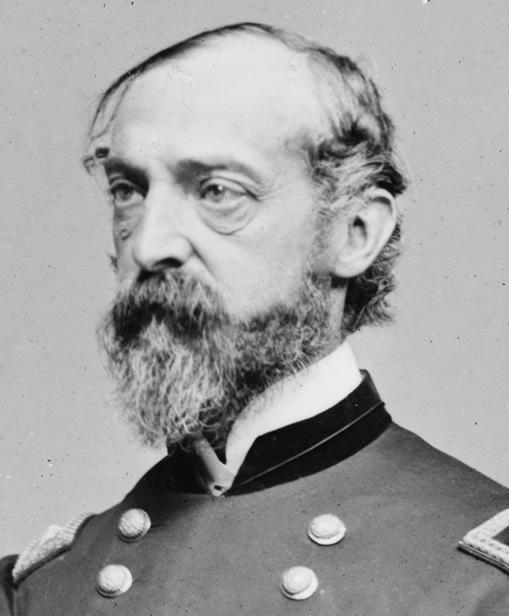 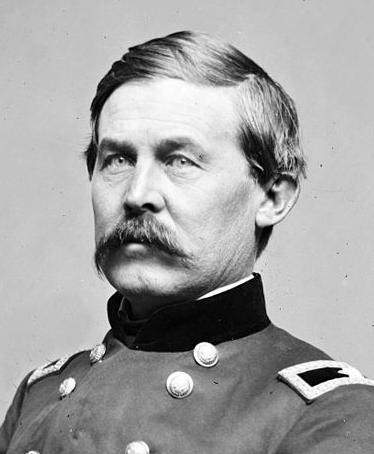
Union Generals George Meade and John Buford
June 30: The first Union-Confederate encounter at Gettysburg
It was Meade's intention to set up a defensive position for his army in
Maryland just south of the Pennsylvania border along Pipe creek, in
order to protect Washington and Baltimore. But events beyond his
control would soon draw Mead northward into Pennsylvania to the
crossroads town of Gettysburg.
Union cavalry under General Buford were scouting the Gettysburg area to
the north of the main Union army in an effort to locate Lee's army,
when they ran into the some troops from Hill's Corps headed toward
Gettysburg from Chambersburg in search of shoes! The
Confederates, in spotting Buford's forces, turned back to Chambersburg
– and reported the presence of a sizable number of Union troops just
to the northwest of Gettysburg.
Where was Jeb Stuart?
Jeb Stuart was supposed to be doing for the Confederates what Buford
was doing for the Union: locating and reporting back to headquarters
the size and disposition of the enemy. But Jeb Stuart had lost
contact with the main Confederate army weeks before when, rather than
follow Lee closely (as he had been ordered), he headed off to the
northwest, supposedly to put himself between the Union army and
Washington DC. His intention was for this act of bravado to put
the Union army in confusion – as it would supposedly be forced to
choose between following Lee northward and drawing back to the south to
protect its capital. But The Union army showed little interest in
Stuart and had stayed focused on its pursuit of Lee.
Consequently, as the Union army continued to move northward, its
position between Stuart's Confederate cavalry and Lee's main army kept
Stuart from being able to link up or even contact the main Confederate
force. Indeed, not only did Lee not know what Stuart was up to,
Stuart had no idea of what was happening with Lee – or the fact that
the Union and Confederate armies were headed on a collision course at
Gettysburg. Stuart continued to wander around the Pennsylvania
countryside oblivious to Lee's desperate need for cavalry
intelligence – until the battle at Gettysburg was well
underway. Consequently Lee had to make key initial decisions on
where and when to deploy his forces against Meade – without
any solid information about Meade's position.
July 1: The initial clash northwest of Gettysburg
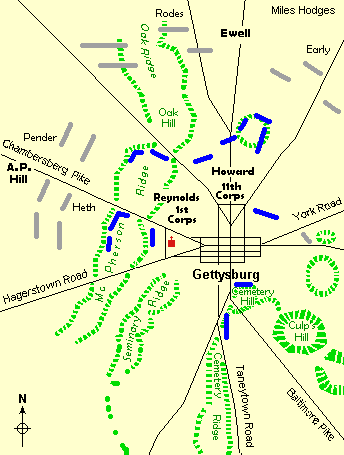
The next day, July 1st, Hill sent
troops
from Gen. Heth's division back to Gettysburg, initially only to scout
out the Union strength (Lee had given explicit instructions that no
actual fighting was to take place until he could get all of his army
assembled outside Gettysburg, as it moved in from different points of
convergence (west, north and northwest). But Lee's plans, as
Meade's, were also overtaken by unanticipated circumstances at
Gettysburg.
Heth's Confederate reconnaissance forces coming down the Chambersburg
Pike and Burford's dismounted cavalry, in position on McPherson's Ridge
just west and north of the town of Gettysburg, inevitably drew
fire on each other as they again met, this time directly. Neither
side was willing to withdraw, which was the only way to avoid action
(which Lee was very clear about avoiding until all his troops were in
place). The battle thus was joined by advanced troops of both
armies just outside Gettysburg, a situation which neither Meade nor Lee
had wanted.
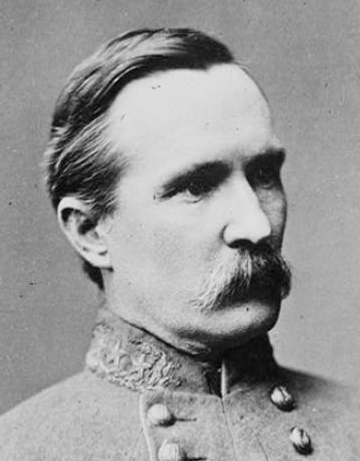 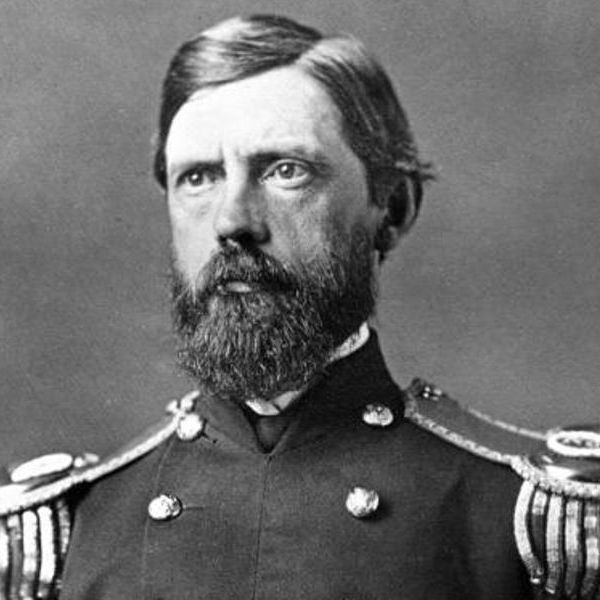 Generals Henry Heth and John Reynolds
Generals Henry Heth and John Reynolds
This conflict on the morning of the 1st was further intensified by the
arrival at Gettysburg from Emmitsburg of Union 1st Corps General John
Reynolds, who had not yet been told of Meade's plan's to form a
defensive line in northern Maryland – but who on the other hand had
been told by Buford about the previous day's encounter with Confederate
troops. Seeing Buford's cavalry trying to hold off a gathering
Confederate force, Reynolds quickly returned to the advance column of
his troops in order to hurry them along in joining up with a
hard-pressed Buford. (Reynold's 1st Corps formed the west-most
wing of a Union line which spread 30 miles from Emmitsburg in the west
to east).
But just as his troops (including the fabled Iron Brigade) began to
arrive and he was placing men and canons in positions across the
Chambersburg Pike, Reyolds was shot and killed. This was a
sign of things to come.
The battle raged back and forth as new troops filed in from either
side. The situation was confusing and a huge loss of life and
capture of enemy troops resulted. As Confederate reinforcements
were closer at hand, the situation turned increasingly in favor of that
side. The first of Ewell's Corps (Rodes Division) began to arrive
from the north and soon the Union 11th Corps found itself vastly
outnumbered. In the meantime the Union 1st Corps was being
overwhelmed to the West by Hill's Corps (Heth's Division) as the
Confederate troops were now sufficient in number to begin to swing
around the Union's southern flank – and threatened to encircle
them. The Iron Brigade tried to hold its position on McPherson
Ridge – but the result was the near total destruction of this highly
reputed brigade.
Late in the afternoon, the Union 1st and 11th Corps were ordered to
fall back through the town – to retreat to Cemetery Ridge
just to the southeast of the town, where Union canon and troops were
being assembled as they arrived from the south. The retreat was
orderly but nonetheless not fully successful, as many Union troops were
fully encircled by the Confederates before they could move out.
Approximately 3,600 Union troops were thus captured by Confederates that
day.
At the head of the Union troops arriving from the south was Major
General Winfield Scott Hancock, who had been ordered by Meade to get to
Gettysburg as fast as possible and begin to lay out a position for the
rest of the arriving Union troops to occupy. It was Hancock's
decision to make Cemetery Hill the centerpoint of the Union
position. As new troops arrived they were placed either to the
south of this point along Cemetery Ridge, to face Hill's Corps coming
in from the west – and along the southeast across Culp's Hill, to face
Ewell's Corps coming in from the east and northeast.
For a moment Ewell was in a position that if he had forced the issue
(as Gen. Early requested) he might have successfully challenged the
Union position atop Cemetery Hill before more Union troops arrived to
take position there. But Ewell hesitated (he was still stinging
from Lee's anger at having started the action before Lee was fully
prepared to do battle) and the opportunity was lost.
Thus did the first day's battle end.
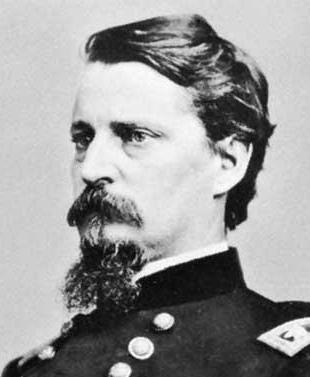 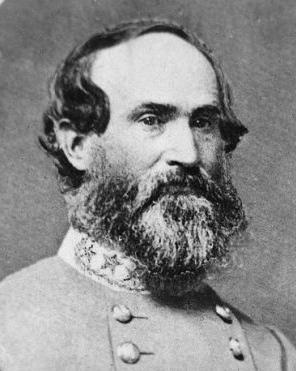
Generals Winfield Scott Hancock and Jubal Early
July 2: Confederate Attacks on the Northern and Southern Wings of the Federal Line
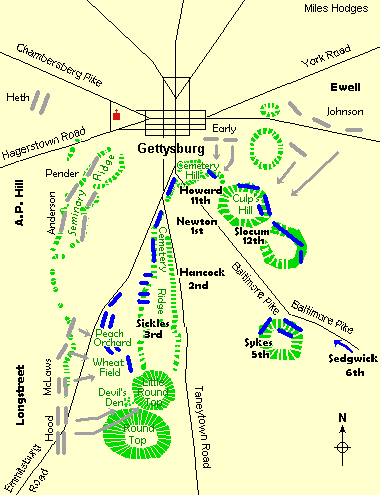
The
next morning, July 2, Lee and Meade's armies were rapidly pouring into
Gettysburg. Meade decided to take advantage of the heights that
his army had moved up to and dug in to await Lee's next move.
Lee meanwhile situated the bulk of his army in the heights of Seminary
Ridge a mile to the west of the Union position. Between the two of them
was a wide expanse of open field that someone was going to have to
cross to get to the enemy. Longstreet advised Lee to hold their
defensive position. But Lee felt that the winning tactic for the
South had always been to press the attack. And to press the
attack was what he was determined to do – even though the Union forces
were quickly getting well dug-in in the heights across the way
Lee determined that he would attack the extremities of the Union line,
directing Ewell to strike the northern end of the Union line at Culp's
Hill – and Longstreet, with his larger forces, to hit the southern end
of the Union line along Cemetery Ridge.
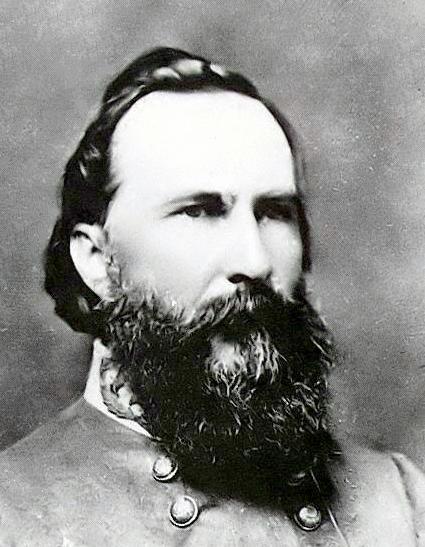 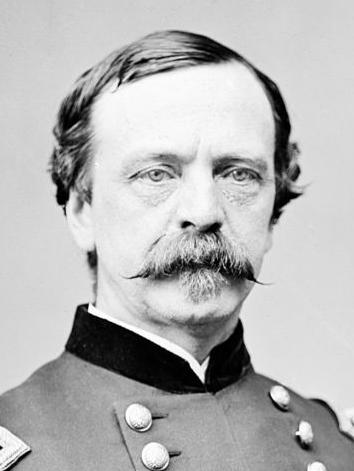
Generals James Longstreet and Daniel Sickles
At the southern front, the Confederate situation was greatly aided by
the foolish decision of General Sickles to bring out his III Corps from
the heights to meet the Confederates under McLaws near a peach orchard
below – badly exposing his men to Confederate encirclement. He
subsequently had to fall back – with great losses in fighting in the
wheatfields behind the peach orchard, throwing part of the Union
position into disarray.
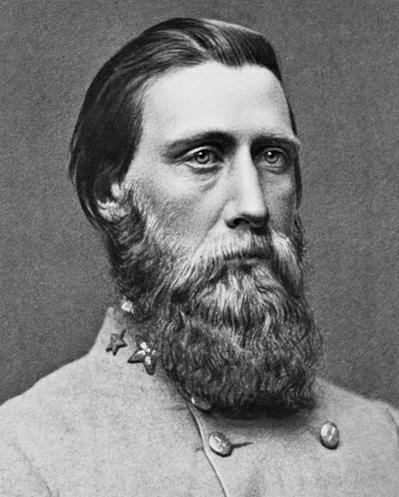 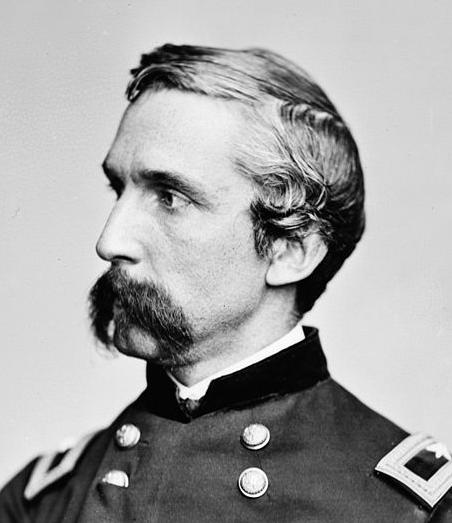
Generals John Bell Hood and Joshua Chamberlain
The Confederates under Hood tried to swing south around behind Sickles
in a race to seize the undefended heights of Little Round Top.
Many were slowed up or stopped in fierce hand to hand fighting in the
boulder-strewn Devil's Den at the foot of Little Round Top. Other's of
Hood's Division tried to sweep around to the south and capture the hill
from that direction. But a small number of Union troops (among
them, the 20th Maine under Chamberlain – brought to today's attention
through the movie Gettysburg), reached this strategic position first
and held it – to then be joined by more Union troops who gathered
there. Repeated Confederate assaults on Little Round Top could not
dislodge the Union soldiers dug in there. With Little Round Top
still held by Union troops, they could make no further advances against
the Union's southern flank.
Meanwhile at the other end of the line of battle, to the north, Ewell
was no more successful in dislodging the Union troops from their
position atop Cemetery Hill and Culp's Hill.
July 3: Pickett's Charge on the Union Center
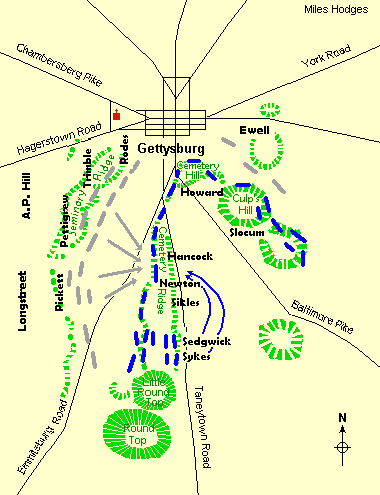
On
the next day, July 3, Lee made the decision to assault the center of
the Union line along Cemetery Ridge. He thought that if he could
break through this position, he could cut the Union army in two and
swing in behind their undefended backs. But to do so, he would
have to cross an open and thus unprotected plain a mile wide to reach
the Union forces well dug in along the low ridge which protected the
Union center.
He hoped that heavy bombardment of that position by cannon might weaken
that position sufficiently to reduce the dangers he faced there.
So from 1:00 to 3:00 in the afternoon the Confederates undertook the
massive expenditure of cannon shell and powder against the Union
position. During this massive barrage the Union troops did not
really respond – but held their fire. In the end, the Confederate
fire and smoke succeeded only in exhausting the supplies of the
Confederate artillery – and in little else.
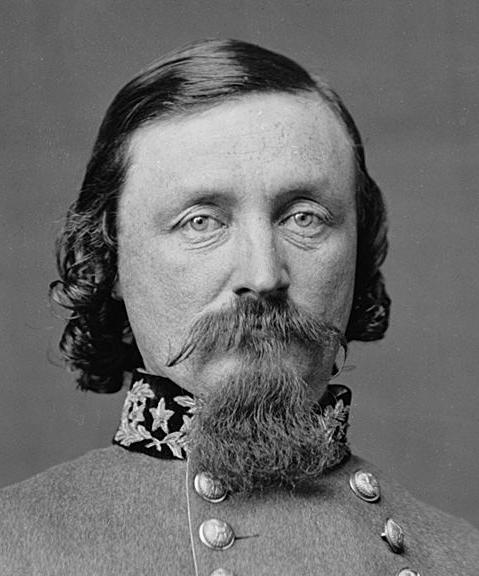 General George Pickett
General George Pickett
Then in a long line the Confederates began to move their troops slowly
across the open fields (in what came to be widely known as "Pickett's
charge") toward Hancock's Union position – in particular
toward a single point of convergence known today as the
"Angle." Union rifle and cannon fire ripped through the
Confederate ranks. Still on they came, led by General Armistead, who
had moved to the front his officer colleagues, who were shot down one by
one. He tried to preserve an orderly advance as they continually
fell before the Union fire. They reached the Angle – but by this
time it was heavily reinforced. He could not break through – and
himself fell, mortally wounded. Finally the Confederates were
faced with no other option but to fall back, having failed to break the
Union lines anywhere. Lee knew that he had lost the battle for
the North that day.
Meade Lets Lee Escape to Virginia
On the following day, July 4, Lee order the retreat of his army – back
toward Virginia. Meade, like the generals before him, did nothing
to pursue the retreating enemy. They were exhausted.
Everyone was exhausted.
It was a grand disaster for the South – and Lee recognized immediately
that he had gambled the lives of his men foolishly. He lost
28,000 of his 70,000 troops. But it had been costly for the North
as well. Meade had lost 23,000 of his army of 90,000.
Nonetheless, it was Lee, not Meade, who had been broken by this
action. Lee would never be able or willing again to try an
assault on the North. Henceforth, the war would be a process of
the South trying to protect itself from invading Northern armies.
This then marks the turning point of the War.
|





 Miles
H. Hodges
Miles
H. Hodges